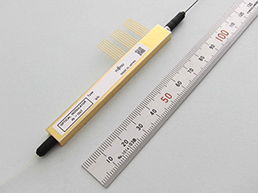Japan
Fujitsu introduces World's First FPC Type 100G/400G LN Modulator
- Direct connection with SMT driver enables reduction in size and drastically improved mounting into optical communication equipment -
Kawasaki, Japan, March 7, 2014- Fujitsu Optical Components Limited (FOC) announced today that on July 1st, 2014 it will be releasing a FPC (*1)type LN modulator (*2)with compact size and low drive voltage to support 100G DP-QPSK (*3)and 400G DP-xQAM (*4)in beyond 100G optical networks. This product will enable direct connection to SMT (*5)drivers which will help to reduce the size and drastically improve the mounting into optical communication equipment.

New services such as mobile broadband using smart devices, social networking, cloud computing, and on-line streaming have led to a rapid increase in the volume of communications traffic. This has created a great demand for 100G optical networks. The requirement for Core Networks to handle larger capacity and longer distance on their links has led to a spread of 100G optical networks using digital coherent transmission systems (*6). R&D activities related to the commercialization of next-generation 400G optical networks have also gained significant momentum. For the transmission portion of these coherent optical transceivers 100G/400G DP-IQ (*7)LN modulators supporting both 100G DP-QPSK and 400G DP-xQAM are required.
Fujitsu Optical Components Limited has successfully commercialized the world's first compact 100G/400G DP-IQ LN modulator with a FPC electrical interface. This product offers a reduction in size and drastically improved mounting into 100G/400G coherent transceivers.
Key Features
- Compact size and FPC RF interface
A volume reduction of about 1/2 compared with conventional 100G DP-QPSK LN modulators was achieved. The same driving voltage as that for the conventional 100G DP-QPSK LN modulator has been able to be maintained by adopting a new processing technology along with a chip design that improves the modulation efficiency of the LN modulator chip. The change from the GPPO RF interface adopted in conventional 100G DP-QPSK LN modulators to the FPC RF interface enables direct surface mounting onto the printed circuit board. - Support for 100G DP-QPSK and 400G DP-xQAM modulation
The improvement of the LN modulator chip characteristics along with the integration of two IQ modulators and polarization beam combiners enables support for both 100G DP-QPSK and 400G DP-xQAM modulation formats. - Compliant with OIF specifications
The 100G/400G DP-IQ LN modulator is compliant with OIF specifications.
Fujitsu Optical Components Limited plans to display samples of this product at OFC 2014 which is scheduled to take place from March 11 to 13 in San Francisco, California, USA.
Pricing & Availability
| Product Name | Pricing | Shipment |
|---|---|---|
| 100G/400G DP-IQ LN modulator | Quoted per order | July 1st, 2014 |
Additional Information
- http://www.fujitsu.com/jp/foc/en/
Glossary & Notes
(*1) Acronym for Flexible Printed Circuits. Electric interface that transmits the RF signal and supports surface mounting to the printed circuit board
(*2) LiNbO3 crystal. Intensity modulators convert input electrical signals to optical intensity signals on the output. Phase modulators convert input electrical signals to optical phase signals. One of the features of LN modulators is modulation with minimal wavelength chirping. This is a desirable characteristic for ultra-high speed, long haul, and DWDM (Dense Wavelength Division Multiplexing) transmission.
(*3) Acronym for Dual-Polarization Quadrature Phase Shift Keying. A method of phase modulation for digital signals in which 2 bits of data are allocated to each of 4 modulated optical phases (0, 90, 180, 270°) for both P-polarized and S-polarized light.
(*4) Acronym for Dual Polarization-x Quadrature Amplitude Modulation. A method of phase modulation for digital signals in which multi bits of data are allocated to different modulated optical amplitude and modulated optical phases for both P-polarized and S-polarized light.
(*5) Surface Mount Technology
(*6) Converts the received optical signal to an electrical signal in the optical receiving section after combining the received optical signal with a local reference light. The waveform distortion that occurs in the optical transmission path is then compensated for by digital signal processing. This technique allows for significant reduction in system cost through the elimination of optical dispersion compensators and optical amplifiers (for loss compensation).
(*7) Acronym for Dual Polarization-In-phase Quadrature. A method of phase modulation for digital signals in which multi bits of data are allocated to modulated optical amplitudes and modulated optical phases for both P-polarized and S-polarized light.
Customer Contacts
Fujitsu Optical Components Limited
Sales & Business Development Division
Sales Promotion Department
![]() E-mail: foc-contact-pr@ml.jp.fujitsu.com
E-mail: foc-contact-pr@ml.jp.fujitsu.com
About Fujitsu Optical Components
Fujitsu Optical Components is a leading supplier of advanced, highly reliable, customer-focused optical components for datacom and telecommunication applications in the global market. Its broad product line-up includes100G Coherent Transceiver, 100GE CFP/CFP2 Transceivers, 40G/100G LN Modulators, 100G Integrated Coherent Receivers, SR/IR/LR/DWDM (Fixed & Tunable) XFP Transceivers and SFP+ Transceivers. For additional information, visit http://www.fujitsu.com/jp/foc/en/.
All other company or product names mentioned herein are trademarks or registered trademarks of their respective owners. Information provided in this press release is accurate at time of publication and is subject to change without advance notice.
- arrow-double-r02.gif (01 KB)
- cookie-allowance-bg.gif (02 KB)
- cookie-gig4.css (02 KB)
- cookie-gig4.js (03 KB)
- onload-css.js (00 KB)
日付: 07 March, 2014
About this Website
- Terms of Use
- Privacy
